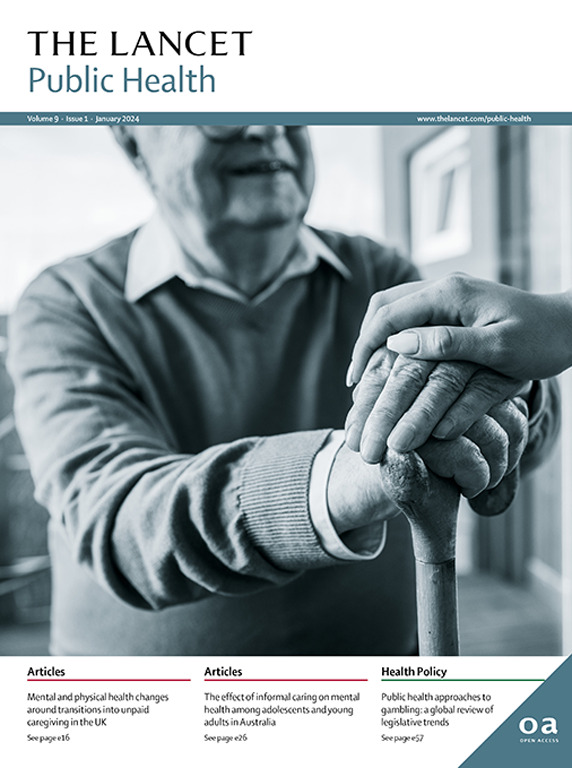Health impact and economic evaluation of the Expanded Program on Immunization in China from 1974 to 2024: a modelling study
IF 25.4
1区 医学
Q1 PUBLIC, ENVIRONMENTAL & OCCUPATIONAL HEALTH
引用次数: 0
Abstract
Background
The Expanded Program on Immunization (EPI), initiated by WHO in 1974, is a cornerstone of public health. China's EPI covers more than a sixth of the world's population and includes eight routine vaccines with high coverage rates. This study aimed to estimate health and economic impacts of China's EPI over the past 50 years (1974–2024).Methods
This study mathematically modelled the impact of all eight routine vaccines in China's EPI against eight pathogens (measles, pertussis, hepatitis B, tuberculosis, hepatitis A, Japanese encephalitis, meningitis A, and poliomyelitis) based on data availability and their substantial disease burden, particularly accounting for non-linearities in vaccine impact. Health and economic outcomes were determined using mathematical models between a counterfactual scenario without vaccination (vaccine coverage set to zero) and the current vaccination scenario (routine vaccination scheduled at age 0–6 years), based on calendar year and birth cohort approaches. The health impact of China's EPI from 1974 to 2024 was measured in the number of cases, deaths, and disability-adjusted life-years (DALYs) averted.Findings
We estimated that China's EPI averted 703·02 million cases (95% credible interval 699·51–722·80) and 2·48 million deaths (2·14–2·97) in 1974–2024 based on the calendar year approach, equivalent to averting an estimated 160·22 million DALYs (145·05–196·99). Using the birth cohort approach, we predicted 707·41 million cases (703·93–727·03) and 7·01 million deaths (6·95–7·87) averted over the lifetime, corresponding to 279·02 million DALYs (265·78–316·12). From a societal perspective, the aggregated cost of vaccination was estimated to be US$124·06 billion (120·49–127·49), although the benefits amounted to $2417·85 billion (2359·38–2710·35). China's EPI yielded an aggregate benefit–cost ratio of 19·48 (18·82–22·08) from the societal perspective and 8·02 (7·64–8·80) from the provider's perspective.Interpretation
China's EPI has shown remarkable health and economic achievements, contributing to worldwide EPI success in the past 50 years. Further investment in EPI is warranted to sustain coverage and expand vaccine inclusion in China and globally.Funding
Beijing Natural Science Foundation.Translation
For the Chinese translation of the abstract see Supplementary Materials section.1974 - 2024年中国扩大免疫规划的健康影响和经济评价:一个模型研究
世卫组织于1974年发起的扩大免疫规划(EPI)是公共卫生的基石。中国的扩大免疫计划覆盖了世界六分之一以上的人口,包括八种常规疫苗,覆盖率很高。本研究旨在评估过去50年(1974-2024)中国EPI对健康和经济的影响。方法本研究基于数据可得性和它们的实质性疾病负担,特别考虑了疫苗影响的非线性,对中国扩大免疫计划中所有八种常规疫苗对八种病原体(麻疹、百日咳、乙型肝炎、结核病、甲型肝炎、日本脑炎、甲型脑膜炎和脊髓灰质炎)的影响进行了数学建模。根据历年和出生队列方法,利用数学模型确定了没有接种疫苗的反事实情景(疫苗覆盖率设为零)和当前接种疫苗情景(0-6岁常规接种疫苗)之间的健康和经济结果。从1974年到2024年,中国EPI对健康的影响以避免的病例数、死亡人数和残疾调整生命年(DALYs)来衡量。研究结果:根据日历年方法,我们估计中国的EPI在1974-2024年期间避免了7.032亿例病例(95%可信区间为699·51-722·80)和248万例死亡(2·14-2·97),相当于避免了估计的1.6·22亿DALYs(145·05-196·99)。使用出生队列方法,我们预测在整个生命周期中避免了7.0741亿例病例(7.393 - 7.2703)和701万例死亡(6.95 - 7.87),对应于2.7902亿DALYs(2.6578 - 3.1612)。从社会角度来看,疫苗接种的总费用估计为12460亿美元(12049 - 12749),尽管收益达2417850亿美元(235938 - 271035)。从社会角度看,中国EPI的总收益成本比为19.48(18.82 ~ 22.08),从提供者角度看,总收益成本比为8.02(7.64 ~ 8.80)。在过去的50年里,中国的EPI在健康和经济方面取得了显著成就,为全球EPI的成功做出了贡献。有必要对扩大免疫计划进行进一步投资,以维持中国和全球疫苗的覆盖范围并扩大疫苗的包容性。北京市自然科学基金。摘要的中文译文见补充资料部分。
本文章由计算机程序翻译,如有差异,请以英文原文为准。
求助全文
约1分钟内获得全文
求助全文
来源期刊

Lancet Public Health
Medicine-Public Health, Environmental and Occupational Health
CiteScore
55.60
自引率
0.80%
发文量
305
审稿时长
8 weeks
期刊介绍:
The Lancet Public Health is committed to tackling the most pressing issues across all aspects of public health. We have a strong commitment to using science to improve health equity and social justice. In line with the values and vision of The Lancet, we take a broad and inclusive approach to public health and are interested in interdisciplinary research.
We publish a range of content types that can advance public health policies and outcomes. These include Articles, Review, Comment, and Correspondence. Learn more about the types of papers we publish.
 求助内容:
求助内容: 应助结果提醒方式:
应助结果提醒方式:


